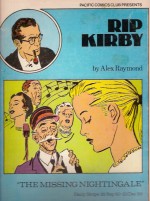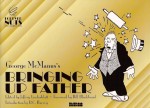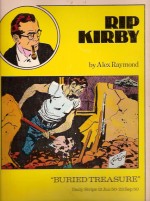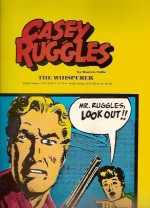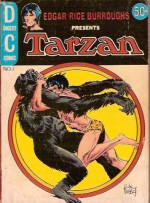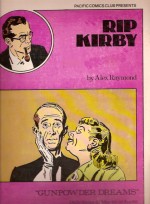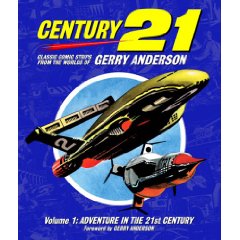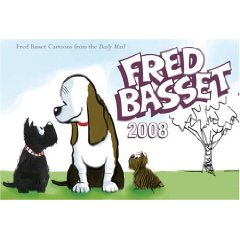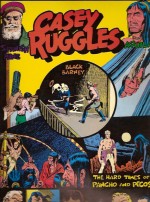
By Warren Tufts (Western Winds Productions)
No ISBN
Warren Tufts was an incredibly gifted artist and storyteller born too late. He is best remembered now – if at all – for creating two of the most beautiful western comics strips of all time, but at a time when the heyday of newspaper syndicated entertainment was gradually giving way to the television age. Had he been working in adventure’s Golden Age he would undoubtedly be a household name – at least in comics fans’ houses
Born in Fresno, California on 12th December 1925 Tufts was a superb, meticulous craftsman with a canny grasp of character and a great ear for dialogue whose art was stately in a representational manner and favourably compared to both Hal Foster’s Prince Valiant and the best of Alex Raymond. On May 22nd 1949 he began the seminal Casey Ruggles – A Saga of the West as a colour Sunday page, following with a daily black and white strip beginning on September 19th of that year, working for the United Features Syndicate, who owned such landmark strips as Fritzi Ritz and L’il Abner.
Ruggles was a dynamic ex-cavalry sergeant making his way to California in 1849 to find his fortune (the storyline of both features until 1950 where daily and Sunday strips divided into separate tales), meeting such historical personages as Millard Fillmore, William Fargo, Jean Lafitte and Kit Carson in gripping two-fisted action-adventures. The lush, expansive tales were crisply told and highly engaging, but Tufts was a driven perfectionist regularly working 80-hour weeks at the drawing board and consequently often missed deadlines.
This led him to use many assistants such as Al Plastino, Rueben Moreira and Edmund Good. Established veterans Nick Cardy and Alex Toth also spent time working as “ghosts†(uncredited assistants and fill-in artists) on the series.
Due to a falling-out Tufts left the strip in 1954 and Al Carreño continued the feature until its demise in October 1955. The departure came when TV producers wanted to turn the strip into a weekly television show but apparently United Features baulked, suggesting the show would harm the popularity of the strip.
Tufts created his own syndicate for his next and greatest project, Lance (probably the last great full page Sunday strip and another series crying out for a high-quality collection) before moving peripherally into comic-books, working extensively for West Coast outfit Dell/Gold Key, where he drew various westerns and cowboy TV show tie-ins like Wagon Train, Korak son of Tarzan, The Amazing Chan and the Chan Clan and a long run on the Pink Panther comic. Eventually he quit drawing completely, working as an actor, voice-actor and eventually in animation on such shows as Challenge of the Super Friends.
Tufts had a lifelong passion for flying, even building his own ‘planes. In 1982 whilst piloting one he crashed and was killed.
The Pacific Comics Club collected many “lost strip classics†at the start of the 1980s, including a number of Casey Ruggles adventures. This colossal black and white volume (approximately 15 inches x 10 inches) contains stories that fit between the first and last tale of the previous volume (see Casey Ruggles: The Whisperer), and leads with a cracking mystery tale as Ruggles tracks down a murderous masked outlaw named ‘Black Barney’ in a dynamic tale that undoubtedly influenced a huge number of comicbook Costumed Cowboys.
This is followed by the eponymous ‘Hard Times of Pancho and Pecos‘ wherein the light relief baddies are so down on their luck that they end up as slaves for an unscrupulous rancher until rescued by Ruggles.
Next up is one of the most impressive western strips of all time: an eerie mood-piece more horror story than sagebrush saga as Ruggles faces the seemingly supernatural threat of the fling beast ‘Aquila‘. As if the tension-soaked drama were not sufficient to chill the blood, the art is a startling monochrome collaboration between supreme realist Tufts and the chiaroscuric stylisation of Alex Toth. No fan of the medium should ever be denied this experience!
This volume concludes with a gripping tale of greed and disaster in ‘Spanish Mine’ as an old treasure map leads to murder, mayhem and a truly spectacular climax…
Human intrigue and fallibility, bombastic action and a taste for the bizarre reminiscent of the best John Ford or Raoul Walsh movie make Casey Ruggles the ideal western strip for the discerning modern audience. Westerns are continually falling into and out of fashion but the beautiful clean-cut artistic mastery of Warren Tufts can never be out of vogue These great tales are desperately deserving of a wider following, and I’m still praying some canny publisher knows a good thing when he sees it…
© 1949, 1950, 1953 United Features Syndicate, Inc. Collection © Western Winds Productions. All Rights Reserved.

